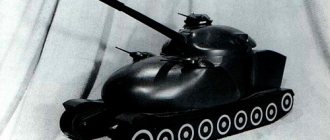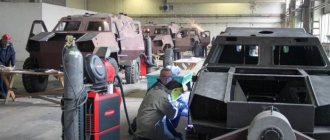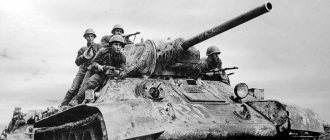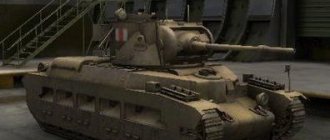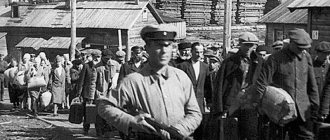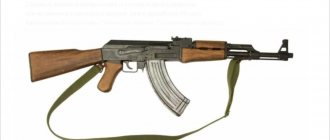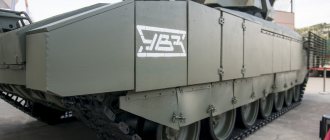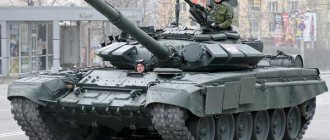All these tanks have three firing modes: cyclic, sequential and salvo.
The main feature of these tanks is the twin two-gun installation. Along with it, completely new shooting modes appear in the game:
Consistent
Sequential mode is firing a second gun without waiting for the first to load. How it works: after firing from the active left gun, the camera will move, but you won’t be able to fire a shot from the right gun right away; you’ll have to wait a little - a special timer will show the waiting time.
This time is less than reloading one barrel. Then you can fire the shot. After the second shot, the reload time for both guns is reset to zero.
Cyclical
Cyclic mode - shooting while waiting for each gun to reload individually. When, for example, the left gun has fired and begins to charge, the right one is activated. Once the left one is charged, you can fire from the right one.
The firing principle is similar to a classic single-barreled tank, only with an additional camera shift when aiming.
Cyclic and sequential firing methods are similar to a reloading drum, like Italian tanks, but with two shells.
Simultaneous firing of two guns (volley)
Salvo mode is only available when both guns are charged. To fire from two barrels at the same time, you need to hold down the mouse button for several seconds - this time is spent preparing for the salvo. Upon completion of preparation, two shots are fired automatically at once.
An important point: after firing, both guns are blocked for some time. Only after a few seconds does normal charging begin. If you release the left mouse button before preparation is complete, the process will be interrupted.
Please note that when firing a salvo, each of the shells is calculated separately. Situations are possible when one of the shells ricocheted or did not penetrate the opponent’s armor. Take this point into account when using salvo shooting mode!
Firing only volleys is not always the best choice. It is better to combine the available shooting modes depending on the situation on the battlefield! Now let's move on to the tanks.
Premium tank Object 703 II
In terms of its performance characteristics, the heavy premium tank Object 703 II resembles another premium tank - the IS-3 with M3. Similarities are observed in one-time damage, accuracy at 100 meters, armor penetration and types of projectiles. The developers are in a hurry to introduce it into the game as soon as possible; the tank has passed several Supertest integrations in a fairly short time. Previously, it could be found in random, including with a postscript (100) - this is a designation of an alternative option.
Initially, the tank came out for testing with a 122 mm gun, and then they decided to test it with a 100 mm gun. The difference lies in one-time damage, accuracy, aiming speed and reload.
| 100 mm. weapon | 122 mm. weapon | |
| Gun reload time (1/2) | 8.5/8.5 sec. | 11/11 sec. |
| Salvo gun preparation time | 2.5 sec. | 3.5 sec. |
| Recharge Lock Time | 6 sec. | 7 sec. |
| Gun change time | 3 sec. | 5 sec. |
As a result, the tank was launched with a caliber of 122 mm. The main thing that makes it difficult to implement damage is poor air-damage, while the pumped-up equipment, on the contrary, is quite comfortable.
Another difference from other Soviet Tier 8 tanks was the absence of the legendary “pike nose”. The nominal armor of the hull in the frontal projection is quite high, but the turret is poorly armored.
The presence of two guns did not greatly affect the dynamics of the tank; in this regard, it is something between the IS-3 and IS-3 with M3, so the premium one will be quite mobile.
History of the project
On our website we examined in detail the epic with the design of the KV-4 tanks . Not a single project was ever accepted, and it seemed that the epic with the design of a super-heavy tank in the USSR was over. But in March 1941, either as a result of a disinformation operation carried out by the Abwehr, or simply due to a misunderstanding, the command of the Red Army received information that supposedly Germany had already completed the creation of tanks with especially powerful armor and these tanks, they even join the troops. And in connection with this information, the leadership of the Red Army decided to return to the KV-4 projects. Or rather, create a completely new tank, so to speak, based on... Taking into account all the comments that appeared during the consideration of projects for the KV-4 tank. And already, on April 7, 1941, the Council of People's Commissars of the USSR and the Central Committee of the All-Union Communist Party of Bolsheviks issued Resolution No. 827-345 ss, which set the task of designing a new super-heavy tank, called the KV-5. On April 9, based on this resolution, an order was issued to the People's Commissariat of Heavy Engineering No. 231 ss:
IS-2-II
It just so happened that the last to enter the SuperTest was the first in the branch of double-barreled tanks IS-2-II level 8.
At his disposal in the top configuration are 100 mm caliber guns with one-time damage of 300 units and armor penetration with a basic 221 mm projectile. As a special sub-caliber 256 mm. The accuracy is not bad, as for a Soviet TT 0.38, and the gun is brought down in 2.5 seconds. In general, the twin guns have good stabilization.
With survivability, things are so-so. The minimum safety factor is 1500 units. The frontal armor of the hull is 110, so even at the top of the list you can’t really count on it. In terms of armor, the turret instills more confidence with 235 mm in the forehead, so it is capable of tanking same-tier vehicles.
The dynamics are quite good for its class. The maximum speed is 34 km/h, and due to the good specific power of 14 hp/t, it will pick it up quickly. The overview is typical for level 8 councils 350 meters.
KV-7 - three-gun version of the KV-1
Its design was original, but obviously unsuccessful. It was planned to install three 76-mm ZiS-5 cannons in the tank's turret. But with this installation, the tower could no longer rotate. The result was not a classic tank, but a self-propelled artillery mount - self-propelled guns.
However, in practice this idea was not realized either. It was decided to leave one 76-mm cannon and additionally install two 45-mm 20K cannons.
Six crew members were required to control and fire a self-propelled gun with three guns. Prototypes were assembled that showed good results during factory tests. But the military rejected the vehicle because they did not understand why self-propelled guns needed three guns aimed at one point at once.
By the way, some armies around the world are now armed with self-propelled guns with coaxial guns. Even in our country it was planned to make the Coalition self-propelled guns double-barreled.
IS-3-II
The Tier 9 heavy tank IS-3-II in its top configuration received a 122 mm gun. The one-time damage is one of the highest, and it has a fairly fast reload, but don’t forget about switching between weapons, which also takes time. A significant drawback of this tank was its catastrophically low armor penetration, the worst among Soviet tanks at level 9, so it will not always be possible to realize approximately 800 units of damage by firing a doublet.
Unlike the premium tank, here the situation with armor is the opposite. The nominal hull armor, even despite the rational angles of inclination of the armor plates, is too weak for level 9. The most protected part is the forehead of the tower.
Stalin, tanks, three barrels
Heavy self-propelled artillery installations in the USSR began to be designed back in the early 30s. By the end of the decade, work on heavy self-propelled guns died down, but at the beginning of 1940 they began again. The Red Army required vehicles designed to destroy enemy bunkers. The result of the designers' work was the self-propelled gun "212", which, however, for a number of reasons was not even completed. In April 1942, the “212” program was finally closed, giving way to another, no less interesting project
–
KV assault tank
—
7.
Initiative from the top
November 1941 was an extremely difficult time for the Soviet Union. The Germans were rushing to Moscow, which was only tens of kilometers away. There were battles on the outskirts of Tula, Rostov-on-Don was lost. The factories evacuated to the East were just beginning to produce new tanks. The Chelyabinsk Tractor Plant, which by the end of the year was renamed ChKZ (Chelyabinsk Kirov Plant, more precisely, the Kirov Plant of the People's Commissariat of Tank Industry in Chelyabinsk), in November became the only enterprise producing heavy KV tanks. Just this month, Tankograd factory workers for the first time managed, and with a large margin, to overcome the mark of 100 tanks produced. The company's staff was significantly replenished by workers and engineers evacuated from Leningrad.
It was during this difficult time that a project for an extremely unusual vehicle appeared, the analogues of which in the world tank building cannot be immediately recalled. This project, which was based on the KV-1 chassis, was first mentioned in the report of Captain P. F. Solomonov on a trip to Chelyabinsk, dated November 28, 1941. The purpose of the trip, initiated by the leadership of the GAU KA, was to study on site the issue of armament provision for KV-1 tanks. In addition to the issues of supplying guns, the report also included some experimental work, among which was the following:
“On the instructions of Joseph Vissarionovich Stalin, the Kirovsky plant is developing a built-in installation in the KV: 1 F-34 cannon and 2 45 mm cannons (barrels without recoil devices), recoil devices for the triplex are taken from the ZIS-5. There is no all-round firing, the horizontal firing angle is +/-15° or +/-7.5° as the installation allows; ammunition capacity is 300 rounds (100 per weapon), in addition, this triplex has 3-4 more machine guns.
In December, the plant should supply 1/5 of all KV tanks with these triplexes.”
One might assume that the name of Stalin was only used to hide behind the name of Stalin, but this is not so. The fact that it was Joseph Vissarionovich who initiated the creation of this design is emphasized in several documents. Moreover, one of the GKO resolutions concerning the machine, which received the KV-7 index, was written by Stalin in his own hand with his “trademark” pencil.
T-34–3, an attempt to create a medium salvo tank with a rotating turret
The reason for the appearance of the KV-7 was numerous requests from the front to increase the firepower of tank guns to combat unarmored targets, including light field fortifications. According to the concept, the built-in installation allowed for both separate firing and a simultaneous salvo. The KV-7 was not the only such project. At the same time, in November-December 1941, a similar machine was designed by the team of plant No. 183, evacuated to Nizhny Tagil. The tank, designated T-34-3, was developed under the leadership of A. A. Morozov. It was a T-34, in the turret of which, in addition to the F-34, a pair of 45-mm cannons was installed. The crew was increased to 5 people, and the commander was relieved of the functions of a gunner. There is no information about who initiated the development of the T-34-3, although with a high probability it could have been the same person who “ordered” the KV-7. A technical design and design documentation were developed for the T-34-3, but it did not even get to the point of manufacturing a prototype.
Installation U-13, which was installed on the KV-7
In the case of the KV-7, the situation was different, and the project itself was very different from what was developed in Nizhny Tagil. As was the case during the development of the “DOT Fighter” in the Urals, work on the KV-7 was divided between ChKZ and UZTM. The chassis was designed in Chelyabinsk, the development of which was carried out by the SKB-2 team led by G.N. Moskvin. The gun part was handled by OKB-3 UZTM. Work on the installation, which was developed by engineers N.N. Efimov and K.N. Ilyin, began in November 1941 and ended by December 10. F. F. Petrov acted as the chief designer of the system, which received the factory index U-13. A significant role in the creation of the U-13 was played by L. I. Gorlitsky, who arrived from Leningrad in October 1941, and at that time held the position of head of the artillery design bureau of the Kirov plant.
Unlike the T-34–3, the creators of the KV-7 decided to abandon the rotating turret, since the U-13's built-in installation took up too much space. Instead of the turret and roof of the fighting compartment, the KV-7 was equipped with a specially designed wheelhouse. At the same time, the designers did not use the word “cabinet” in the documents; instead, the term “non-rotating tower” was used. In order to ensure normal working conditions for the crew in the fighting compartment, the wheelhouse was made prismatic in shape. At the same time, its lower part protruded over the entire width of the fenders. In the manufacture of the deckhouse, maximum use was made of parts from the KV-1 turret, including the ball mount for the rear machine gun, hatches on the turret roof and viewing devices.
Drawing of the U-13 casing catcher, dated December 10, 1941
It should be noted that in documents of that period the KV-7 was not called a self-propelled gun. Formally, this vehicle was called either simply “KV-7 tank” or “assault tank”. However, by all indications, it was precisely a self-propelled artillery installation. The KV-7 became the first self-propelled gun and the first combat vehicle in general, which was developed in the Urals and brought to the prototype stage. According to factory documents, repair tank No. 5161, produced in September 1941, was used as the basis for the creation of the KV-7. This vehicle not only received a new wheelhouse and weapons. Its chassis has also undergone a number of changes.
Attempting to create a doublet
ChKZ took work on the KV-7 topic very seriously. The phrase about “every fifth tank” was not an empty phrase at all. Simultaneously with the development of design documentation and the manufacture of a prototype, plant No. 200 was preparing to launch series production of hulls. On December 30, 1941, the chief engineer of plant No. 200, L. I. Eiranov, signed the technical conditions for the production of an installation batch of 20 buildings. It is unknown exactly how many KV-7 hulls were eventually made, but judging by the further development of events, the pilot batch was nevertheless assembled.
KV-7 during factory tests, late December 1941
Meanwhile, on December 27, 1941 (10 days behind schedule), the KV-7 prototype passed factory tests. Due to the rush, a new sight was not ready for him. However, there were complaints that were much more serious. According to the report, the U-13 installation had an unsuccessful design of a screw-type rotating mechanism with two hinges, which led to a large dispersion when firing. Captain P.F. Solomonov, who controlled the tests from the GAU spacecraft, compiled a list of more than a dozen shortcomings that required correction. True, most of them simply did not have time to fix them in the allotted time - by January 5, the KV-7 was expected in Moscow.
KV-7, side view
On the appointed day, tests took place at the testing ground of plant No. 8 in Mytishchi. At the same time, the vehicle was inspected by a commission, which included the heads of GABTU, GAU, NKV, as well as Voroshilov and Kotin. During standing fire, only with the third salvo was it possible to achieve a simultaneous shot from three barrels at once, while the accuracy at a distance of 400 meters turned out to be quite low. Tests on rate of fire from a place gave results at a level of 20 to 24 rounds per minute. Separately, the rate of fire from each gun turned out to be approximately at the level of conventional tanks, and the very idea of volley fire was called into question. If the 76-mm F-34 cannon managed to fire 3 shots in 34 seconds, then the 45-mm tank guns fired 5 shots each. However, the commission found the rate of fire satisfactory. In addition to the low accuracy of fire, especially during a salvo, the thickness of the frontal armor was unexpectedly found to be insufficient. It was proposed to increase it to 110–120 mm. In addition, it was proposed that instead of a triple installation, we develop a twin one - with two 76-mm guns.
Having received data on the test results, Stalin personally drew up GKO decree No. 1110ss “On the production of KV-7 and KV-8 tanks.” The first item in it was: “The presented 3-gun model “KV-7” should be set aside.”
. There was no talk of a complete cancellation of work on the KV-7, but the production of the pilot batch of vehicles never took place. On January 27, tactical and technical requirements were drawn up for a vehicle with a twin installation of 76-mm ZIS-5 guns.
KV-7 with a pair of 76-mm ZIS-5 cannons, March 1942
As in the case of the gun system of the first version of the KV-7, work on the twin installation of 76-mm ZIS-5 guns was entrusted to UZTM. The general supervision of the work was led by L. I. Gorlitsky. N.V. Kurin and G.F. Ksyunin also worked on the installation, which received the factory index U-14. Judging by the dates on the drawings of individual parts of the installation, design began no later than January 25, 1942, that is, even before the tactical and technical requirements were received. The design of the U-14 lasted until mid-February, and in the second half of the month work began on the production of the modernized KV-7. The assault tank was not built from scratch, but the existing KV-7 was converted with a U-13 installation. At the same time, there was no need to rebuild the wheelhouse itself. The changes affected only the gun mantlet and ammunition racks.
In this form, the KV-7 was supposed to be sent for military trials
The test program for the modernized KV-7 was prepared for March 7, 1942. It was supposed to fire 400 shots and conduct a 50-kilometer run, but in reality everything turned out differently. Due to the workload of ChTZ and the removal of top priority from the KV-7, tests at the Kopeisk test site took place only on May 14. A rate of fire of 6–7 rounds per minute was achieved, and due to the imbalance of the system, the sight was knocked down after each shot. Stowing ammunition was considered inconvenient, and the rotating mechanism of the coaxial installation required two-handed operation. At this point the tests were completed. Interest in the KV-7 has faded.
The last “lifetime” photo of the KV-7, taken in the fall of 1943 at the site of plant No. 100
The KV-7 was mentioned again in October 1942. During the business trip of P. F. Solomonov (by that time already in the rank of major) to the Kirov plant, an SPG was inspected. Its sea trials have also passed. In November, a proposal was received from the GAU KA to modify the KV-7 by installing a commander's cupola, debug all systems and send it for military testing. Although this idea was abandoned, the KV-7 still managed to serve the benefit of the Soviet tank industry. A planetary transmission was tested on the car, which was developed by the team of the Moscow Mechanical Engineering Institute named after. Bauman under the leadership of G.I. Zaichik. Then the KV-7 ended up at the site of plant No. 100, and in December 1943, the long-suffering self-propelled gun, along with the KV-9 and KV-12, was sent to scrap metal.
Don't let the good go to waste
Back in early January 1942, the GABTU began to discuss the issue that something more powerful could be installed in the KV-7 control room than a triple installation of 76 and 45 mm caliber guns. The initial proposal was to install a 152 mm M-10 howitzer.
By the end of January, S. A. Ginzburg had prepared requirements for a self-propelled 152 mm howitzer based on the KV-7. In the plan for experimental work for 1942, approved by the People's Commissar of the Tank Industry Malyshev on January 21, this installation is numbered 59. According to the plan, the Kirov Plant (ChKZ) was responsible for the self-propelled part of the “bunker fighter”, and UZTM was responsible for the artillery part. Design drawings were expected by March 15, a prototype self-propelled gun by May 1, and drawings for the series by May 10. 300 thousand rubles were allocated for the work. Compared to the costs of the “212” project, the amount was small, but here we were not talking about creating a vehicle from scratch, but about reworking the hulls of the KV-7 assault tanks that were already in stock.
The appearance of this vehicle caused a mixed reaction in the GAU KA, because the artillerymen still wanted to get a self-propelled gun based on the KV-3 with a BR-2 cannon. As for the development of a self-propelled gun based on the KV-7, it seemed to them not suitable enough. True, the artillerymen soon had to reduce their requests, since at the beginning of April it became finally clear that there would be no “DOT Fighter” with the BR-2.
Project of 152-mm self-propelled gun U-18
On April 15, 1942, a plenum of the Artillery Committee of the GAU KA was held, dedicated to the development of self-propelled artillery. It was he who finally approved the directions along which Soviet self-propelled artillery would subsequently develop. Regarding the issue of heavy self-propelled guns, the following decision was made:
«2) Bunker fighters - 152-mm BR-2 cannon on a special chassis from units of the KV tank.
The work will be entrusted to the Kirov Plant (NKTP) with the involvement of Plant No. 221 (NKV). In view of the fact that obtaining a chassis for this self-propelled gun is associated with great difficulties, it is considered advisable to limit ourselves to obtaining a design for this self-propelled gun in the near future.
Temporarily limit ourselves to installing a 152-mm gun-howitzer mod. 1937 in the body of the KV-7 tank. The work will be entrusted to the Kirov Plant (NKTP) and Plant No. 172 (NKV).”
Soon, instead of plant No. 172 NKV, work on the gun part was entrusted to UZTM. Thus, cooperation on the KV-7 topic between Uralmash and ChKZ continued. The topic, which had been worked on in Sverdlovsk since the beginning of 1942, received the factory index U-18. As in the case of the U-13 and U-14 installations, L. I. Gorlitsky led the development of the ML-20 installation in the KV-7.
Reconstruction of the appearance of the U-18
For various reasons, the development of installing a 152-mm howitzer in the KV-7 wheelhouse was delayed. The preliminary design was ready only on August 4, and was presented a month later - on September 3, 1942. A group of UZTM designers led by Gorlitsky tried to invest as much as possible in the requirements of the military, as well as to minimize the alteration of the KV-7 hull. The artillery part of the U-18 installation consisted of only 13 units, while the hull and wheelhouse of the KV-7 were not subject to alterations. This approach to maximum “non-interference” in the design of the KV-7 can be easily explained by a phrase from the description of the U-18:
«The KV-7 tank is best suited as a base for this self-propelled gun. Several dozen hulls with turrets for this tank are located at the Kirov plant in the city of Chelyabinsk, intended for triple installations of one 76.2 mm and two 45 mm tank guns.”
It would seem that with this approach, the development of the UZTM Design Bureau team was the best suited for mastering the groundwork. The ending of the story was all the more unexpected. On September 24, 1942, the chief engineer of UZTM M. G. Umnyagin received a letter signed by the head of the 6th department of the BTU GABTU KA, engineer-colonel Kovalev:
“On your No. 3655/48s dated 4.9.42 on the project of the U-18 self-propelled gun, I inform you that a similar project proposed by Comrade Petrov from 12.9 to 14.9.42 was discussed at a meeting of the Technical Committee of the Council of the People's Commissariat of Armament.”
Just like that, quite suddenly, the story of the U-18 ended before it even really began. The U-18 and U-19 self-propelled guns, developed under the leadership of Gorlitsky, remained paper projects. They settled so densely in the archives that they were completely forgotten. Only the indices were heard, which later, due to a lack of information, were assigned by domestic historians to projects developed in the design bureau of plant No. 8 under the leadership of F. F. Petrov. Each of them is worthy of a separate story.
Sources:
- TsAMO RF
- Author's archive
- Archive of Gennady Malyshev
- Archive of Sergei Ageev
ST-II
The Tier 10 heavy tank ST-II is also equipped with 122 mm guns and retains the one-time damage from the previous model, but armor penetration has significantly increased, and now the tank can more confidently resist its classmates on the front line. The remaining characteristics of the weapon are mediocre, forcing you to constantly be in close combat. Medium and even more so long range are not at all about this tank.
It is also worth noting the faster reload time of the two-gun mechanics compared to the IS-3-II. Therefore, it has higher variability for implementing the features of its branch.
As for survivability, the armor in the hull is still not enough to tank single-tier vehicles; even most of the “nines” will be able to penetrate the hull without any problems. The frontal projection of the turret and the gun mantlet are, in fact, the main ability to tank. A large supply of strength points will certainly contribute to your survival in battle.
